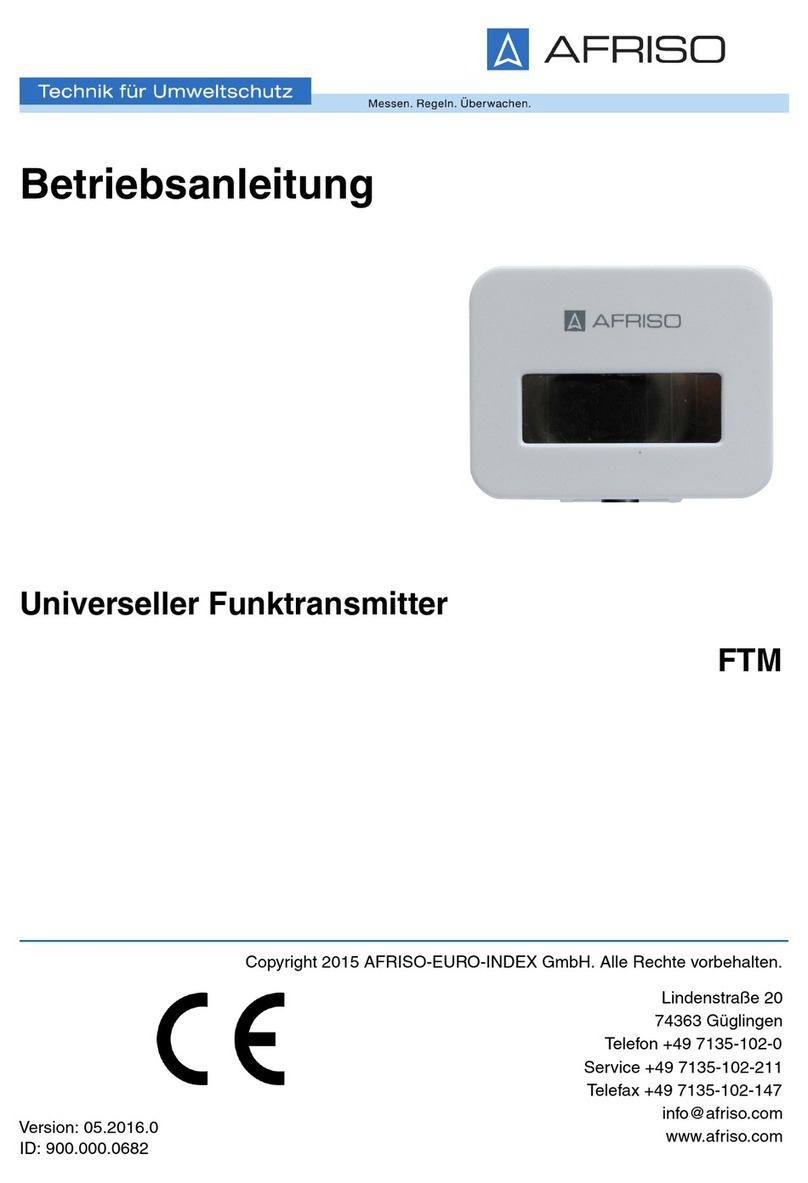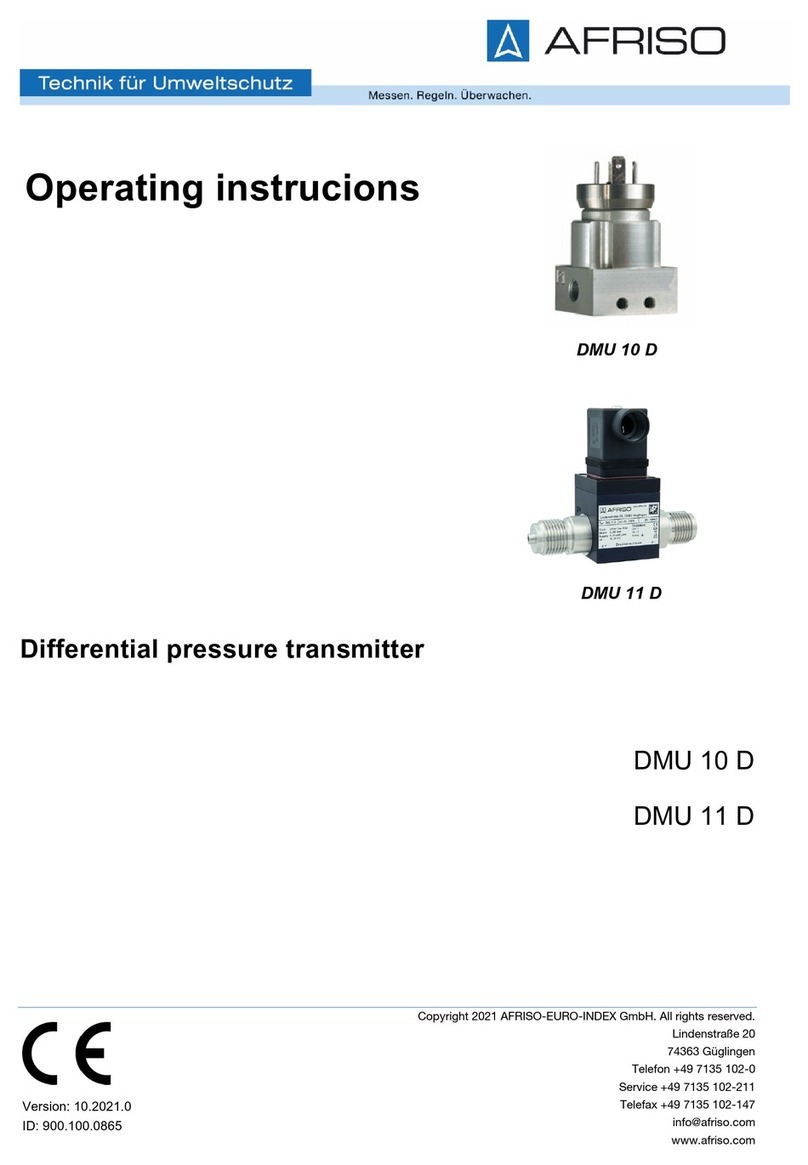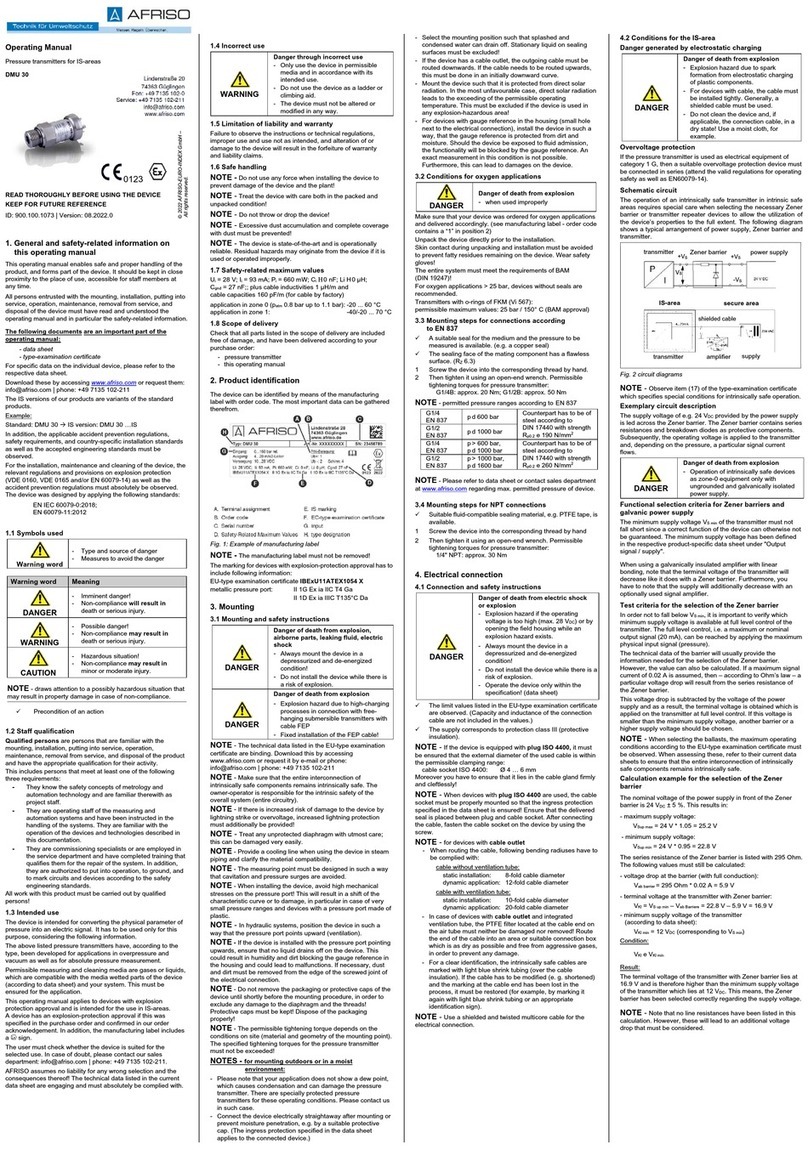
© 2021 AFRISO-EURO-INDEX GmbH –
All rights reserved.
Translation of the Lindenstraße 20
Original Operating Manual 74363 Güglingen
Fon: +49 7135 102-0
Service: +49 7135 102-211
info@afriso.com
www.afriso.com
Pressure Transmitters / screw-in probes
DMU 01, DMU 01 K, DMU 03, DMU 03 HD,
DMU 04, DMU 05P, DMU 07, DMU 07 FG
READ THOROUGHLY BEFORE USING THE
DEVICE
KEEP FOR FUTURE REFERENCE
ID: 900.100.0831 Version: 10.2021.0
1. General and Safety-Related Information on
this Operating Manual
This operating manual enables safe and proper
handling of the product, and forms part of the
device. It should be kept in close proximity to the
place of use, accessible for staff members at any
time.
All persons entrusted with the mounting, installation,
putting into service, operation, maintenance,
removal from service, and disposal of the device
must have read and understood the operating
manual and in particular the safety-related
information.
The following documents are an important part
of the operating manual:
- Data sheet
For specific data on the individual sensors, please
refer to the respective data sheet.
Download these by accessing www.bdsensors.de or
request them by e-mail or phone: info@afriso.com |
Fon: +49 7135 102-211
In addition, the applicable accident prevention
regulations, safety requirements, and country-
specific installation standards as well as the
accepted engineering standards must be observed.
1.1 Symbols Used
- Type and source of danger
- Measures to avoid the
danger
Warning word Meaning
DANGER
- Imminent danger!
- Non-compliance will
result in death or serious
injury.
WARNING
- Possible danger!
- Non-compliance may
result in death or serious
injury.
- Hazardous situation!
- Non-compliance may result
in minor or moderate injury.
– draws attention to a possibly hazardous
situation that may result in property damage in case
of non-compliance.
Precondition of an action
1.2 Staff Qualification
Qualified persons are persons that are familiar with
the mounting, installation, putting into service,
operation, maintenance, removal from service, and
disposal of the product and have the appropriate
qualification for their activity.
This includes persons that meet at least one of the
following three requirements:
- They know the safety concepts of metrology
and automation technology and are familiar
therewith as project staff.
- They are operating staff of the measuring and
automation systems and have been instructed
in the handling of the systems. They are
familiar with the operation of the devices and
technologies described in this documentation.
- They are commissioning specialists or are
employed in the service department, and have
completed training that qualifies them for the
repair of the system. In addition, they are
authorized to put into operation, to ground,
and to mark circuits and devices according to
the safety engineering standards.
All work with this product must be carried out by
qualified persons!
1.3 Intended Use
The devices are used to convert the physical
parameter of pressure into an electric signal.
The pressure transmitters are exclusively suited
for measuring positive, negative and absolute
pressures.
The screw-in probes are exclusively suited to
filling-level and process measuring technology.
The user must check whether the device is suited
for the selected use. In case of doubt, please
contact our sales department (info@afriso.com).
AFRISO assumes no liability for any wrong selection
and the consequences thereof!
The fluids that can be measured are gases and
liquids that are compatible with the materials in
contact with the fluids, described in the data sheet.
For application, it must additionally be ensured that
the fluid is compatible with the parts in contact with
the fluid.
1.4 Limitation of Liability and Warranty
Failure to observe the instructions or technical
regulations, improper use and use not as intended,
and alteration of or damage to the device will result
in the forfeiture of warranty and liability claims.
1.5 Safe Handling
NOTE – Treat the device with care both in the
packed and unpacked condition!
NOTE – The device must not be altered or modified
in any way.
NOTE – Do not throw or drop the device!
NOTE – Excessive dust accumulation (over 5 mm)
and complete coverage with dust must be
prevented!
The device is state-of-the-art and is operationally
reliable. Residual hazards may originate from the
device if it is used or operated improperly.
1.6 Scope of Delivery
Check that all parts listed in the scope of delivery
are included free of damage, and have been
delivered according to your purchase order:
- Pressure transducer or screw-in probe
- for mech. connections to DIN 3852: O-ring
(premounted)
- this operating manual
2. Product Identification
The device can be identified by means of the type
plate with order code. The most important data can
be gathered therefrom.
1 2 3 4 5 6
1Type designation 4Order code
2Input 5Terminal assignment
3Output 6Serial number
Fig. 1: Type plate
NOTE – The type plate must not be removed!
3. Mounting
3.1 Mounting and Safety Instructions
DANGER
- airborne parts, leaking fluid,
electric shock
- Always mount the device in a
depressurized and de-
energized condition!
NOTE – If there is increased risk of damage to the
device by lightning strike or overvoltage, increased
lightning protection must additionally be provided!
NOTE – Treat any unprotected diaphragm with
utmost care; this can be damaged very easily.
NOTES – for mounting outdoors or in a moist
environment:
- Connect the device electrically straightaway after
mounting or prevent moisture penetration, e.g. by
a suitable protective cap. (The protection rating
specified on the data sheet applies to the
connected device.)
- Select the mounting position such that splashed
and condensed water can drain off. Stationary
liquid on sealing surfaces must be excluded!
- If the device has a cable outlet, the outgoing cable
must be routed downwards. If the cable needs to
be routed upwards, this must be done in an
initially downward curve.
- Mount the device such that it is protected from
direct solar radiation. In the most unfavorable
case, direct solar radiation leads to the exceeding
of the permissible operating temperature. This
must be excluded if the device is used in any
explosion-hazardous area!
- A device with gauge reference in the housing
(small hole next to the electrical connection) must
be mounted such that the gauge reference is
protected against dirt and humidity. If the
transducer is exposed to liquid admission, the
gauge reference will be blocked, and the
equalization of air pressure will be prevented. In
this condition, a precise measurement is
impossible and damage to the transducer may
occur.
- Provide for a cooling section if the device is used
in a steam line.
NOTE – When installing the device, avoid high
mechanical stresses on the pressure port! This will
result in a shift of the characteristic curve or to
damage, in particular in case of very small pressure
ranges and devices with a pressure connection/port
made of plastic.
NOTE – In hydraulic systems, arrange the device
such that the pressure port points upwards.
(venting)
NOTE – If the device is installed with the pressure
port pointing upwards, ensure that no liquid drains
off on the device. This could result in humidity and
dirt blocking the gauge reference in the housing,
and could lead to malfunctions. If necessary, dust
and dirt must be removed from the edge of the
screwed joint of the electrical connection.
NOTE – Do not remove the packaging or protective
caps of the device until shortly before the mounting
procedure, in order to exclude any damage to the
diaphragm and the threads!
Protective caps must be kept! Dispose of the
packaging properly!
NOTE – The specified tightening torques must not
be exceeded!
3.2 Mounting Steps for Connections According
to DIN 3852
NOTE –Do not use any additional sealing material
such as tow, hemp or Teflon tape!
The O-ring is undamaged and seated in the
designated groove.
The sealing face of the mating component has
a flawless surface. (RZ 6.3)
1 Screw the device into the mating thread by
hand.
2 Devices with a wrench flat must be tightened
using a suitable open-end wrench.
Wrench flat made of steel:
G1/4: approx. 5 Nm; G1/2: approx. 10 Nm;
G3/4: approx. 15 Nm; G1: approx. 20 Nm
Wrench flat made of plastic:
max. 3 Nm)
3 Devices equipped with a knurled ring:
only tighten by hand
3.3 Mounting Steps for Connections According
to EN 837
A suitable seal for the measured fluid and the
pressure to be measured is available. (e.g. a
copper seal)
The sealing face of the mating component has
a flawless surface. (RZ 6.3)
1 Screw the device into the mating thread by
hand.
2 Then tighten it using an open-end wrench: G1/4:
approx. 20 Nm; G1/2: approx. 50 Nm
3.4 Mounting Steps for NPT Connections
Suitable fluid-compatible sealing material, e.g.
PTFE tape, is available.
1 Screw the device into the mating thread by hand
2 Then tighten it using an open-end wrench: 1/4
NPT: approx. 30 Nm; 1/2 NPT: approx. 70 Nm
3.5 Mounting Steps for Female Threads M20x1.5
and 9/16 UNF (for Extreme-Pressure Devices)
WARNING
- Due to wrong installation
- Do not use any seal!
NOTE – The high-pressure tube will seal metallically
in the chamfer on the pressure port. (sealing cone
60°)
1 Screw the high-pressure fitting into the female
thread on the pressure transducer.
2 Then tighten it using an open-end wrench:
approx. 120 Nm.
3.6 Mounting Steps for Milk Pipe Connections
The O-ring is undamaged and seated in the
designated groove.
1 Center the milk pipe connection in the
corresponding mating fitting.
2 Screw the sleeve nut onto the mating fitting.
3 Then tighten it using a hook wrench.
3.7 Mounting Steps for Clamp and Varivent®
Connections
A suitable seal for the measured fluid and the
pressure to be measured is available.
1 Place the seal onto the corresponding mating
fitting
2 Center the clamp connection or Varivent
connection above the corresponding mating
fitting
3 Then fasten the device using a suitable fastener
(e.g. half-ring or retractable ring clamp
connection) according to the instructions
specified by the manufacturer
3.8 Mounting Steps for Flange Connections
A suitable seal for the measured fluid and the
pressure to be measured is available. (e.g. a
fiber seal)
1 Position the seal between the connecting flange
and the mating flange
2 Then attach the device to the mating flange
using 4 or 8 bolts/nuts (depending on flange
design)
4. Electrical Connection
4.1 Connection and Safety Instructions
WARNING
-
Improper installation may result
in electric shock
- Always mount the device in a
depressurized and de-
NOTE –If the device is equipped with a cable
fitting and/or cable box, it must be ensured that the
outer diameter of the line used is within the
permissible clamping range. Additionally it must be
ensured that this is seated firmly and gaplessly in
the cable fitting!
NOTE –Use a shielded and twisted multicore cable
for the electrical connection.
NOTE –for devices with cable outlet
- When routing the cable, the following minimum
bend radii must be observed:
Cable without air hose:
fixed installation: 5-fold cable diameter
flexible use: 10-fold cable diameter
Cable with air hose:
fixed installation: 10-fold cable diameter
flexible use: 20-fold cable diameter
- In case of devices with cable outlet and
integrated ventilation hose, the PTFE filter
located at the cable end on the relative pressure
hose must neither be damaged nor removed!
NOTE –When devices with ISO 4400 are used, the
cable box must be properly mounted so that the
protection rating specified on the data sheet is
ensured! Ensure that the seal supplied is installed
between the connector and the cable box. After
connecting the cable, attach the cable box to the
device by means of the screw.
NOTE –On a device equipped with field housing,
the connection terminals are located underneath the
housing cover. The cover must be screwed off in
order to connect the device electrically. Before the
cover is screwed on again, the O-ring and sealing
surface on the housing must be checked for damage
and, if necessary, replaced! Then screw on the
cover by hand and make sure that the field housing
is tightly closed again.























